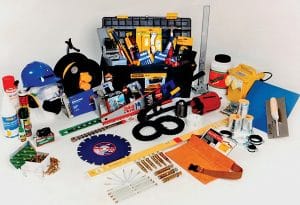 To meet industry standards, soldering consumables are becoming more advanced, safe and environment-friendly
To meet industry standards, soldering consumables are becoming more advanced, safe and environment-friendly
By Baishakhi Dutta
Soldering consumables or filler metals are widely used in various applications across diverse industries like electronics, plumbing, metalwork and more. Soldering offers fairly permanent but reversible connections.
In the electronics field, soldering connects electrical wiring and electronic components on to printed circuit boards (PCBs). Soldering wires, soldering braids, soldering paste, flux and soldering chemicals are some of the consumables available in the market currently.
What’s new in the market
Today, solder materials incorporate the most advanced solder technology for increasingly challenging applications. Materials like lead-free solder pastes, tin-lead formulations for traditional and crossover manufacturing, flux solutions for dual-wave and lead-free processes, cored solder wire and solid solder wire, are now available to meet the demands of all kinds of applications. Listed below are some of the soldering materials that are in demand at present.
- Solder paste suitable for miniaturised assemblies: The miniaturisation of PCBs to produce smaller consumer products has compelled manufacturers to obtain suitable consumables for such devices. Products like smartphones, laptops and desktops require paste deposits as small as 200 microns x 200 microns. At the same time, very large scale integration of electronic components demands small spacing (pitch) and a large number of connections, which further complicates the paste printing operation. Assemblers and OEMs today have access to halogen- and lead-free solder paste to optimise print performance.
Solder paste is also specially designed for use in vacuum reflow with nitrogen; no-clean, lead-free solder paste reduces voiding to less than 1 per cent in the measured void area. Solder paste with properties like a melting point of 227°C, flux content of 11.5 per cent mass and spread factor of 75 per cent is currently available. The paste is also formulated to deliver optimal reflow with minimum mid-chip solder balling. - Low-temperature solder paste: Low-temperature SMT soldering is being widely adopted as it can save component and laminate costs. It helps to replace costly wave soldering, as it enables shorter process flows that not only save energy but also mitigate the damaging effects of thermal shock in wave soldering.
- Aqueous and lead-based consumables: Today, consumers are demanding aqueous and lead-free consumables. Lead-free material exhibits extremely low voiding in-pad joints, good coalescence and optimal solderability over a wide range of surfaces. In addition, the paste has very low residues and minimal hot slump.
- Adhesives that withstand thermal preheats: In order to accommodate new and varied manufacturing conditions, players are offering adhesives that can withstand the thermal preheats required for palletised selective soldering. These consumables can provide a broad activation range, accommodating various process parameters and meet extended thermal demands. Silicone heat transfer compound plus (HTSP) from Electrolube, which is offered by Sumitron, provides thermal conductivity together with a wide temperature range obtained by using silicone-based oils.
- Soldering flux: Electronics flux can be made of rosin, be water-based, or be of the no-clean variety. All are about the same quality with regard to de-oxidising the copper so that a good solder bond can be made. Rosin flux leaves an ugly, sticky residue. Cleaning it off takes either a lot of water, or a chemical solvent. One shouldn’t leave it on, as it is slightly corrosive, and can also be somewhat conductive. So rosin flux is falling out of usage due to the environmental impact of cleaning. Water-based (a.k.a. resin) flux is not sticky and therefore the most preferred in the market, at present.
How to make the right buying decision
There are many companies that offer highly advanced soldering consumables in different price ranges. Most companies currently offer lead-free variants that adhere to international standards. However, there are certain points that must be borne in mind before zeroing in on a particular soldering consumable. These are:
- Potential buyers must look at the quality of the product. They should ensure that the product is consistent and will deliver the expected results.
- The long shelf life of the product is another important factor that should be kept in mind.
- High surface insulation resistance should also be ensured.
- A buyer should check that the product does not leave behind residues.
- A good hole-fill capability is another factor that should be checked.
- Buyers should also look into the raw materials being used by the manufacturer.
- The soldering consumables should be lead free and, if not, buyers should be aware of the fact.
- The quality control process being followed during manufacturing should also be checked.
A few products available in the market
Chemtronics BGA wick repair consumables
 The wick is fabricated from high density copper strands, which are precisely cross-braided to eliminate
The wick is fabricated from high density copper strands, which are precisely cross-braided to eliminate
oxygen penetration in the pores and therefore ensure fast and safe desoldering. The copper ensures optimum heat transfer via the braid to the excess solder to quickly melt and suck it without damaging the circuit board.
Contact: www.sumitron.com
Chemtronics Circuit Works’ flux pens
This pen applicator is ideal for smooth and precise application of varied ranges of flux on conductive  circuit traces. The flux used is non-corrosive, halide free and dries almost instantly at room temperature to minimise flux wastage. It features a chiseled tip that provides the exact delivery of flux to a surface. It is a refillable flux applicator, and also has a replaceable felt tip and cartridge.
circuit traces. The flux used is non-corrosive, halide free and dries almost instantly at room temperature to minimise flux wastage. It features a chiseled tip that provides the exact delivery of flux to a surface. It is a refillable flux applicator, and also has a replaceable felt tip and cartridge.
Contact: www.sumitron.com
Kester’s solder formulation
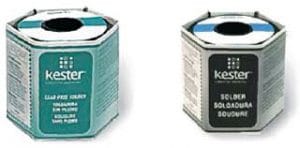 Kester’s wire and bar products have been developed to perform well during hand- and automatic-soldering. These create better solder joints than the conventional lead-free solder alloys. The joints are smooth and have a shine. The shrinkage effects are not visible.
Kester’s wire and bar products have been developed to perform well during hand- and automatic-soldering. These create better solder joints than the conventional lead-free solder alloys. The joints are smooth and have a shine. The shrinkage effects are not visible.
Contact: www.sumitron.com
Fuji SMT glue
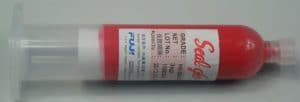 Fuji SMT glue is a thermo-setting epoxy adhesive that can preserve stability and is used for chip or SMD mounting machines. It has high heat-resistivity and good electrical properties. Its high curing temperature and long life make it suited to micro printability with high speed dispensers.
Fuji SMT glue is a thermo-setting epoxy adhesive that can preserve stability and is used for chip or SMD mounting machines. It has high heat-resistivity and good electrical properties. Its high curing temperature and long life make it suited to micro printability with high speed dispensers.
Contact: www.sumitron.com
Kester’s solder paste
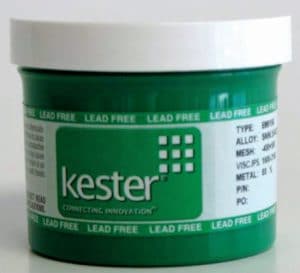 This solder paste is of the no-clean, water soluble, halogen-free and lead-free variety. It is best suited for solder paste printing. It can work with a wide range of printing options such as different printer speeds and long idling timings, and can be used in a wide range of temperature and humidity settings. It has good soldering and wetting properties in air or nitrogen reflow, and supposedly results in minimum defects after soldering and fewer voids. It works well with most conformal coating materials.
This solder paste is of the no-clean, water soluble, halogen-free and lead-free variety. It is best suited for solder paste printing. It can work with a wide range of printing options such as different printer speeds and long idling timings, and can be used in a wide range of temperature and humidity settings. It has good soldering and wetting properties in air or nitrogen reflow, and supposedly results in minimum defects after soldering and fewer voids. It works well with most conformal coating materials.
Contact: www.sumitron.com
ELSOLD cored solder wires
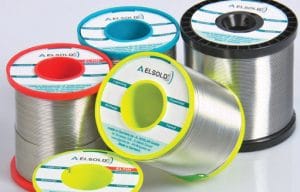 ELSOLD cored solder wires are available in a wide range. What is most innovative about these wires, aside from the purity of the base metal, is the constant adaptation of flux compounds to production parameters and processes. This means that rosins and activators must be adapted to higher or modified processing temperatures.
ELSOLD cored solder wires are available in a wide range. What is most innovative about these wires, aside from the purity of the base metal, is the constant adaptation of flux compounds to production parameters and processes. This means that rosins and activators must be adapted to higher or modified processing temperatures.
Contact: www.bergengroupindia.com


































